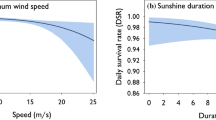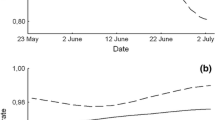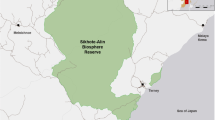Abstract
In territorial microtines intra-specific density dependent processes can limit the maturation of individuals during the summer of their birth. This may have demographic consequences by affecting the number and the age distribution of breeding individuals in the population. Little is known about this process on a community level, though populations of many northern microtine species fluctuate in synchrony and are known to interfere socially with each other. We experimentally studied the influence of the field vole Microtus agrestis on maturation, breeding, space use and survival of weanling bank voles, Clethrionomys glareolus. Two additive competition experiments on bank vole populations were conducted in large outdoor enclosures, half of them additionally housing a field vole population. In a mid-summer experiment low population density and absence of older breeding females minimised intra-specific competition. Survival was not affected by the presence of field voles. Season had a significant effect on both the probability of maturation and breeding of the weanlings. Competition with field voles significantly delayed breeding, and coupled with seasonal effects decreased the probability of breeding. In a late-summer experiment breeding and survival of bank vole weanlings were studied for three weeks as part of a high density breeding bank vole population. Weanlings did not mature at all nor were their space use and survival affected by the presence of field voles. Our results show that competition with other species can also have an impact on breeding of immatures. In an extreme seasonal environment, even a short delay of breeding may decrease survival chances of offspring. Seasonal and competition effects together may thus limit the contribution of year born females to reproductive output of the population. Other studies have shown that adult breeding bank voles suffer lower survival in the presence of field voles, but this study showed no survival effects on the weanlings. Thus it might be beneficial for weanlings to stay immature especially in the end of the breeding season and postpone reproduction to the next breeding season if densities of competing species are high.
Similar content being viewed by others
References
Begon, M., Harper, J.L. and C.R. Townsend (1996) Ecology–Individuals, Populations, Communities. 3rd edition. Blackwell Scientific Publications, Oxford.
Bondrup-Nielsen, S. and Ims, R.A. (1986) Reproduction and spacing behaviour in a peak density population of Clethrionomys glareolus. Holarct. Ecol. 9, 109–112.
Boonstra, R. (1994) Population cycles in microtines: the senescence hypothesis. Evol. Ecol. 8, 196–219.
Boutin, S. (1990) Food supplementation experiments with terrestrial vertebrates: patterns, problems, and the future. Can. J. Zool. 68, 203–220.
Bujalska, G. (1985) Regulation of female maturation in Clethrionomys species, with special reference to an island population of C. glareolus. Ann. Zool. Fenn. 22, 221–342.
Bujalska, G. and Grüm, L. (1989) Social organisation of the bank vole (Clethrionomys glareolus, Schreber 1780) and its demographic consequences: a model. Oecologia 80, 70–81.
Cole, F.R. and Batzli, G.C. (1978) Influence of supplemental feeding on a vole population. J. Mamm. 59, 809–819.
Connell, J.H. (1983) On the prevalence and relative importance of interspecific competition: evidence from field experiments. Am. Nat. 122, 661–696.
Eccard, J.A. and Ylönen, H. (2001) Initiation of breeding after winter in bank voles: effects of food and population density. Can. J. Zool. 79, 1743–1753.
Eccard, J.A. and Ylönen, H. (2002a) Direct interference or indirect exploitative interspecific competition? Experimental evidence through fitness costs in voles. Doctoral Thesis, University of Jyväskylä, Finland.
Eccard, J.A. and Ylönen, H. (2002b) Who carries the fitness costs of interspecific competition in an age structured breeding population in voles? Doctoral Thesis, University of Jyväskylä, Finland.
Gilbert, B.S., Krebs, C.J., Talarico, D. and Cichowski, D.B. (1986) Do Clethrionomys rutilis females suppress maturation of juvenile females? J. Anim. Ecol. 55, 543–552.
Gliwicz, J. (1981) Competitive interactions within a forest rodent community in Central Poland. Oikos 37, 353–362.
Grant, P.R. (1970) Experimental studies of competitive interaction in a two-species system II. The behaviour of Microtus, Peromyscus and Clethrionomys species. Anim. Behav. 18, 411–426.
Grant, P.R. (1969) Experimental studies of competive interaction in a two-species system. I. Microtus and Clethrionomys species in enclosures. Can. J. Zool. 47, 1059–1082.
Gurevitch, J., Morrow, L.L., Wallace, A. and Walsh, J.S. (1992) A Meta-analysis of competition in field experiments. Am. Nat. 140, 539–572.
Halle, S., Eccard, J.A., Jakob, J. and Ylönen, H. (1999) Verhaltensänderungen der Roetelmaus (Clethrionomys glareolus) als Antwort auf interspezifischeKonkurrenz. Z. Säugetierkunde 145, 14.
Hansson, L. (1983) Competition between rodents in successional stages of taiga forests: Microtus agrestis vs Clethrionomys glareolus. Oikos 40, 258–266.
Henttonen, H. and Hansson, L. (1984) Interspecific relations between small rodents in European boreal and subarctic environments. Acta Zool. Fennica 172, 61–65.
Iverson, S.L. and Turner, B.N. (1972) Winter coexistence of Clethrionomys gapperi and Microtus pennsylvanicus in a grassland habitat. Am. Nat. 88, 440–445.
Kaikusalo, A. (1972) Population turnover and wintering in the bank vole Clethrionomys glareolus (Schreb.), in southern and central Finland. Ann. Zool. Fenn. 9, 219–224.
Kaitala, V., Mappes, T. and Ylönen, H. (1997) Delayed female reproduction in equilibrium and chaotic populations. Evol. Ecol. 11, 105–126.
Kenward, R.E. and Hodder, K.H. (1997) An analysis system for biological location data, Wareham, UK.
Löfgren, O. (1995) Niche expansion and increased maturaion rate of Clethrionomys glareolus in the absence of competitors. J. Mamm. 76, 1100–1112.
Mappes, T. and Ylönen, H. (1997) Reproductive effort of female bank voles in a risky environment. Evol. Ecol. 11, 591–598.
Ostfeld, R.S. (1985), Limiting resources and territoriality in microtine rodents. Am. Nat. 129, 1–15.
Prevot-Julliard, A.C., Henttonen, H., Yoccoz, N.G. and Stenseth, N.C. (1999) Delayed maturation in female bank voles, Clethrionomys glareolus: optimal decision or social constraint. J. Anim. Ecol. 68, 684–697.
Schoener, T.W. (1983) Field experiments on interspecific competition. Am. Nat. 122, 240–285.
SPSS (2001) SPSS Inc., Chicago.
Stenseth, N.C., Bjornstad, O.N. and Falck, W. (1996) Is spacing behaviour coupled with predation causing the microtine density cycle? A synthesis of current process-oriented and pattern oriented studies. Proc. R. Soc. Lond. B 263, 1423–1435.
Tkadlec, E. and Zejda, J. (1998) Small rodent population fluctuations: The effects of age structure and seasonality. Evol. Ecol. 12, 191–210.
Viitala, J. (1977) Social organisation in cyclic subarctic populations of the voles Clethrionomys rufocanus (Sund.) and Microtus agrestis (L.). Ann. Zool. Fenn. 14, 53–93.
Author information
Authors and Affiliations
Corresponding author
Rights and permissions
About this article
Cite this article
Eccard, J.A., Klemme, I., Horne, T.J. et al. Effects of competition and season on survival and maturation of young bank vole females. Evolutionary Ecology 16, 85–99 (2002). https://doi.org/10.1023/A:1016387318107
Issue Date:
DOI: https://doi.org/10.1023/A:1016387318107




